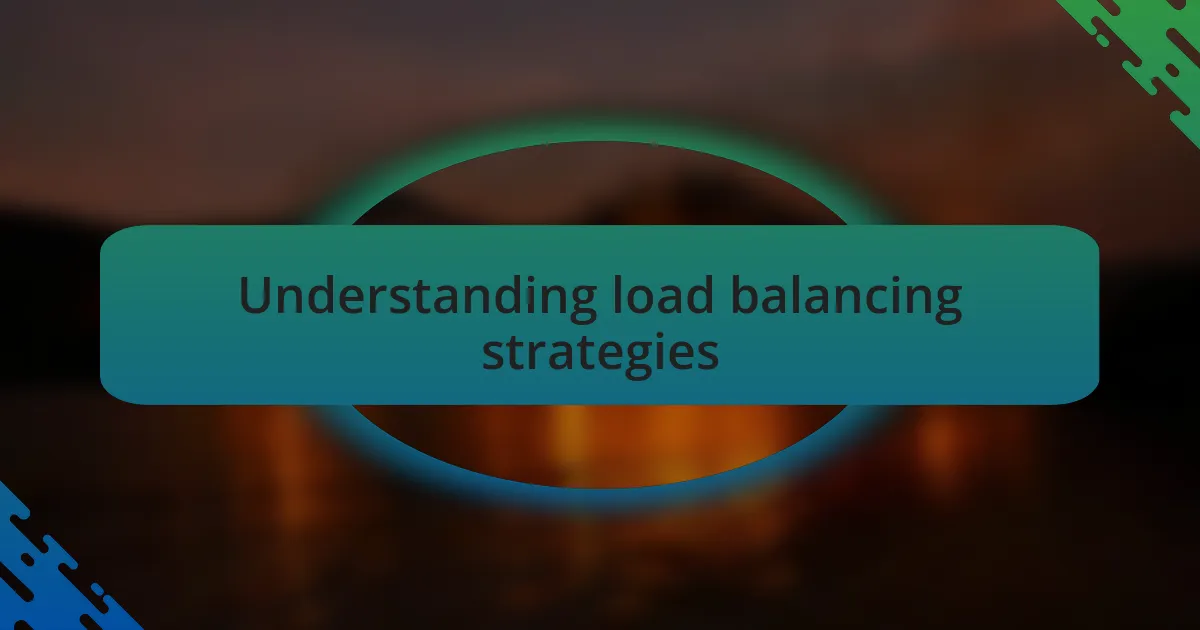Key takeaways:
- Effective load balancing strategies are essential for optimizing server performance and enhancing user experience, with methods like round-robin, least connections, IP hashing, and least response time each serving unique roles.
- Challenges in load balancing implementation include ensuring session persistence, scaling dynamically during traffic spikes, and managing monitoring systems for alerts without causing alarm fatigue.
- Key lessons learned emphasize the importance of documentation, team collaboration in decision-making, and the necessity of ongoing learning to stay updated with evolving tools and best practices.

Understanding load balancing strategies
When diving into load balancing strategies, it’s vital to first grasp their fundamental purpose: distributing incoming traffic effectively across multiple servers. I remember the day I first encountered this concept while working on a project that suddenly received an influx of users. The servers were overwhelmed, and I quickly realized how essential a load balancer was to maintain user experience. That chaos was a lesson that stayed with me.
One strategy that stands out is round-robin, where requests are sent to servers in a rotating manner. I found myself pondering the simplicity of this approach during one particularly busy day, appreciating how elegantly it handled tasks. While it’s straightforward, I also learned that it isn’t always the best choice for resource-intensive applications. It made me wonder—does this basic method truly suffice for modern applications, or are more advanced strategies needed to cope with today’s demands?
Another intriguing method is least connections, which directs traffic to the server with the fewest active connections. I recall implementing this in a situation where some servers were more powerful and could handle more requests. The improvement in performance was noticeable. It highlighted a key lesson: load balancing isn’t merely about spreading the load but optimizing the distribution for efficiency and speed. How often do we consider not just balancing the load but also enhancing the user experience in our strategies?

Types of load balancing methods
A less common but highly efficient method I’ve encountered is IP Hashing. This strategy assigns a specific server based on the client’s IP address, creating a consistent connection for returning users. I remember implementing this for a loyalty program, where keeping users connected to the same server significantly improved their experience. It’s fascinating how this method balances both load distribution and user continuity, don’t you think?
Weighted Load Balancing is another approach I’ve found particularly effective. In this method, servers are assigned weights depending on their capacity, directing more traffic to capable servers. During a project, our strongest server had a significantly higher weight, which optimized performance dramatically on high-demand days. I often reflect on how this method isn’t just about balance; it’s about recognizing the unique strengths of each resource.
Lastly, the Least Response Time strategy is one I always appreciate for its responsiveness. This method routes traffic to the server that can respond the quickest, which was especially beneficial when I was managing a live event application. The reduced latency made a noticeable difference in user satisfaction. Have you considered how crucial response time is in load balancing? It made me realize that, in our race for speed, user experience should always be at the forefront.

Challenges faced during implementation
One of the biggest challenges I faced when implementing load balancing was ensuring that the configuration met the distinct needs of my application. I vividly remember a project where we needed to balance traffic while ensuring session persistence. It was frustrating to see users unintentionally dropped from sessions, affecting their experience. Have you ever encountered that kind of disruption? It reminded me how critical it is to thoroughly test settings before going live.
Scaling solutions effectively can also present hurdles. I encountered issues when our traffic suddenly spiked, far beyond what we anticipated. That experience taught me that having a dynamic scaling strategy is essential. I had to react quickly to add more resources, which felt like building a plane while flying it. It’s a valuable lesson; preparation can make all the difference when facing unexpected load.
Finally, dealing with the complexities of monitoring and alerting systems became a daunting task. I recall spending late nights configuring alerts to ensure we were on top of any potential issues. It was rewarding, yet exhausting, to fine-tune alerts that would notify us of problems without causing alarm fatigue. How do you balance the need for vigilance with the risk of overwhelming your team? I found that keeping the communication lines open within the team was vital in making sure everyone remained informed and responsive.

Lessons learned from my experience
Lessons learned from my experience
One of the most significant lessons I learned was the importance of documentation. Early on, I often relied on my memory to recall specific configurations and decisions. More than once, I found myself puzzled months later about why I made a particular choice. It struck me that meticulous documentation not only saves time but also aids in onboarding new team members. Have you ever tried to decipher your past decisions? It can feel like solving a puzzle without the picture.
Additionally, I realized that load balancing is not just about technology; it’s about people too. I remember a time when I didn’t involve my team in the decision-making process, thinking I could handle it all myself. That approach backfired. The team had fresh insights that could’ve streamlined our strategy. Their perspective helped me see things through a different lens. I often ask myself: how can we collectively enhance our strategies? Collaboration proved to be a game changer in our load balancing approach.
Finally, the necessity of ongoing learning became clear. Staying updated with the latest tools and best practices was something I underestimated initially. There were moments when I stumbled upon new techniques that would have made our processes far more efficient if I had adopted them earlier. It was humbling to realize how fast the landscape evolves. Are you keeping up with changes in your field? Continuous learning not only enhances our skills but also inspires creativity in problem-solving.